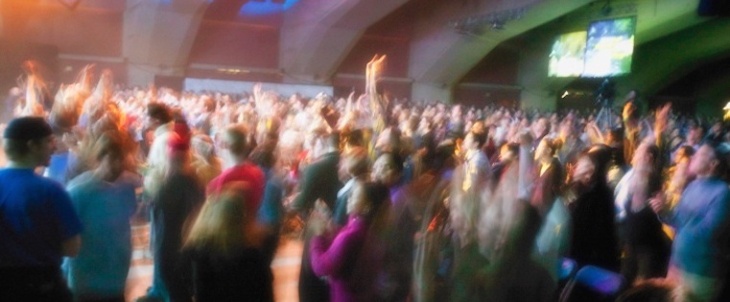
by admin | Jul 10, 2018 | Technology
Welcome to 2018. We’re on the verge of self-driving cars, holodecks, AI assistants, jetpacks, and drone pizza delivery. The shift in digital technologies is happening at such a staggeringly rapid pace that it can be difficult to keep up if you are not constantly watching the trends. In this post, we are going to take a closer look at one emerging trend – augmented reality (AR), and how it is being applied to marketing and brand recognition in the physical realm of trade shows.
Why Trade Shows Still Matter
Trade shows act as an important tool for sales generation and business development across many industries. In fact, the Center for Exhibition Industry Research reports that attendees spend an estimated $44.8 billion and exhibitors spend an estimated $24.5 billion at events annually. The challenge for organizers and exhibitors is finding ways to stand out from the hundreds of other booths on the floor. More progressive companies are looking at creative uses of augmented reality that drastically transform their trade show booth and create the buzz necessary to get people into the sales funnel.

While AR is still relatively new in the arena of virtual reality technologies, it made headlines back in 2016 with the release of Pokemon Go. Today, consumer uses of AR are becoming more commonplace (Google is working on an AR update to the Google Maps mobile app!), the B2B market has plenty of room to grow when it comes to utilizing this technology. Companies that recognize the potential stand to gain a huge edge over their competition in the trade show environment.
Utilizing AR in the Trade Show Environment
Below are just a few examples of how augmented reality can be used in your trade show booth.
- Have a new product with something special that you don’t want anyone to miss? Let your guests zoom in and spin around a 3D model that places your product on a pedestal in your booth and creates a lifelike representation.
- Do you operate around the world? Create an application that drops guests into exotic locations and let users get a taste of your global appeal.
- Need better ways to convey key information? Augment traditional displays to uniquely display diagrams and infographics, videos and photos, and FAQ’s about your product in an interactive and engaging way.
- Engage attendees. Expand your space. Create interactive product demos and infographics. Take ALL your products with you. Increase leads. Drive frictionless sales. Need we say more?
Today’s B2B companies need to leverage technology to get the most out of their trade show experiences and avoid becoming just another face in the crowd. If you aren’t using tools like augmented reality to create a more compelling and interactive booth and drive engagement, your competitors will be and that means fewer sales and new clients for you.
Contact Alt Ethos today to talk about your ideas about using augmented reality at your trade show booth.

by ethanbach | Jun 1, 2018 | Highlights, Technology
Virtual Reality is increasing in popularity with a projected 171 million users in 2018. Although VR has made some great strides, there are still plenty of areas of exploration and innovation to be examined. With these areas of research there are people dedicating their time on all fronts pushing the boundaries and bringing VR outside the box. It is this type of ethos that creates breakthroughs in using technology to connect people. This exploration last year took me to the ix symposium 2017 entitled Embodied Spaces where they focused on making virtual reality a broader full body experience.
Pushing the boundaries of VR
The ix symposium put on by Société des Arts Technologiques gives a platform for innovators and creators to showcase how they are leading in areas of development of VR, dome, and other experiential uses of technology to embody the experiences. For the sake of this blog post, I will focus on VR.
VR, like many things excels in certain areas and lacks in others. The places where VR excels are in gaming, previsualization, helping reprogram tramas (such as PTSD), and demonstrating and proving concepts. Others are exploring uses for movies, artworks, virtual travel, and meditation. We are still trying to figure out this technology and see where it lands. Some have made it their mission.

Tolerance
One of the main limitations of VR at this point is the problem of fatigue. I spoke to the researchers at eleVR whose focus in on the study and experiment of immersive reality with a focus on VR and AR. Their main areas study include exploring increasing time spent using the technology and to “understand how to expand computational interfaces beyond fingertip-focused to become body-conscious and thicken computational spaces from the flat land of screens to fully three-dimensional environments.”
One researcher in particular, M. Eifler, caught my attention. She had begun using VR years ago and was extremely vulnerable to motion sickness and fatigue. She spent the next few months building a yoga regimen for building tolerance for VR. She was able to build her tolerance from just 3 to 5 minutes to 5 to 6 hours. She would often spend a large portion of her work day in VR having meetings and working.
Movement
In the search for movement solutions in VR, many people have been creating all types of contraptions to heighten the body mind experience. Movement should become a lot easier with new wireless VR headsets, but one still wants to be safely moving in real space while moving around the virtual environment.
One solution I tried at ix was the treadmill. There are several VR treadmills out there that offer safety for a single user experience. For my treadmill experience, I had to sign a waiver and there were a couple staff nearby watching to make sure I didn’t fall off. My favorite part in the game I was immersed in had me walk across a beam with images of nothing but clouds on either side. I quite literally began to wobble a bit as I tried to find my “balance” on the beam. Of course I knew I would not fall off, but part of my brain was convinced that I needed to balance on the imaginary beam otherwise I’d fall to my demise.
More recently, I sat in a robotic pod. My eyes covered with VR, sound coming from speakers in the pod located near my ears, and a joystick in either hand as I rode a roller coaster and shot at dragons that looked a lot like bats. The experience was 8 minutes long and as the pod moved up and down, left and right to mimic the visuals of the roller coaster. It was an intensified version of my previous VR experience. Admittedly, as a person who can proudly stand up while wearing VR and experiencing a roller coaster ride, and loves the thrill of jumping out of planes, I was on the verge of feeling sick from too much movement.
VR in a Dome
By now you probably know that one of my favorite environments is a digital dome (See The Rise of the Digital Dome). The dome is a group virtual experience that breaks down a lot of the limitations of VR:
- Average fatigue is 30 – 50 minutes instead of 3 – 5 minutes,
- Movement is not a problem because you can see where you are going
- There are recent developments in group interactions
But what if you combine the dome and VR?

ix touched on this phenomenon with demonstrations of navigating VR with an audience viewing the user experience. We also witnessed what it could be like to use VR to create 3d objects and design while being voyeurs in the dome.
Our team here at Alt Ethos has created VR experiences for a variety of applications including pure entertainment, new concept design walkthroughs, and dome previsualization. We look forward to developing content and experience solutions to help people with PTSD, meditation, and finding empathy for others.
Why ix?
One of my favorite places on the planet is the Société des Arts Technologiques. For years I have admired their vision and dreamt of building an amazing facility for research and exploration of experiential media. Of course, ix is going to be one of my favorite conference. And maybe it’s because I spoke at the very first one in 2014 under the theme of “Valorization & Sharing”. SAT and its founders, Monique Savoie and Luc Courchesne, helped inspire me to start my two organizations, Alt Ethos and Denver Arts + Technology Advancement.
Montréal is amazing. It’s one of the most supportive cities for arts and technology. I’ve witnessed some of the most beautiful street art in Montréal including the 21 Balançoires or musical swings. And on a nice day one can go to the park and hang out people playing music, drinking beer and smoking weed just enjoying life.
I’m impressed with the symposium and what they deliver year after year. This year’s theme is The Conquest of Reality and runs May 29th through June 2nd. Each year I have attended has been one of the best times connecting with old people old friends and making new ones. And of course for me there’s the organizers and the founders of society and technology that I get to nerd out with and catch up one life. I know how hard they work and how hard they have worked in I’m following a similar journey working to establish something similar here in Denver.
If you are curious about trying VR, come join us at our open studio June 1 from 5pm to 11pm at Prism Workspaces 999 Vallejo Street #30, Denver CO.
If you have a VR project you would like to actualize, please contact us. We are happy to help.
If you are interested in learning 360 content – check out MORPHOS 360 workshops.

by admin | May 22, 2018 | Case Studies, Community, Other, Technology
Creating a high engagement museum exhibit with the Fort Collins Museum of Discovery
Background
The Fort Collins Museum of Discovery was looking to activate an old exhibit space into an engaging experience, so they turned to Alt Ethos to create a lighting instrument. The previous exhibit displayed a looped video about the music scene in Fort Collins with a set of couches for visitors to sit to watch the video. The exhibit was passive; they wanted an environment that captured visitors’ attention and pushed deeper engagement.

Fort Collins Museum of Discovery
Objectives
1.Create a unique instrument playable by multiple people at the same time.
2. Turn the space into an active experience that engages people of all ages.
Solution
Step 1: User Experience Research
The team began the journey with user experience research to better understand the community that enjoys the museum and the relationship between the vision of the organization, personas of the users, dynamics of the space, and interactions that connect people to the space and vision.
Step 2: Design

Paul and Ethan take a meeting to learn about the museum’s needs.
The design phase highlighted that the tucked away location of the piece was a unique opportunity to engage “sweater holder” parents as well that don’t often interact with the exhibits choosing instead to watch their children and sit off to the side.
The ideal interaction time was approximated around five minutes to ensure adequate flow throughout the other exhibits. The team moved forward with wireless sensing technology located overhead in the room to maximize the life of the exhibit by basing the interaction dynamics off of the position of audience members in the space.
Step 3: Development and Testing

A child dances among the lights, activating new sounds in the space.
The development and testing of the exhibit occurred in a series of sprints. The major benefit of the sprints was iterative testing of the sound curation because in generative sound environments it can be easy to be swept into a cacophony of sound.
Tuning the parameters to limit key aspects of the sound design along with smoothing sensor data was a major breakthrough in the design that pushed the aesthetic of the installation.
Step 4: Implementation and Delivery
Alt Ethos installed the installation over the course of two weeks ensuring that any major physical changes to the environment took place on the Mondays when the museum was closed.
An essential factor in a smooth delivery was remote access to the computers allowing for the team to make changes and improve the software while not onsite. This allowed for a faster delivery time and for changes to take effect rapidly during the installation phase.
Step 5: Evaluation

What formerly was a passive exhibit is now an active space for all ages.
The use of wireless sensing technology also meant that as soon as a person enters the space, they became part of the musical composition. After the implementation and delivery, this dynamic was identified as a key variable in converting passive adults to active participants in the museum experience.
Doing so created an environment ripe for more connections to the space that involved the whole family thus driving more memberships, donations, and buy in from the adults in the local community.
Read more about the space that we use to create our installations.

by admin | May 8, 2018 | Highlights, Technology
It’s nearing summertime, and with the winter thaw, the warm air, and the summer sunshine comes the events season. Music festivals, corporate retreats, conventions, expositions, weddings, and parties parties parties. Logistically, it’s a cutthroat industry, with 32% increase in competition among event planners in 2017 (Eventbrite 3rd Annual Pulse Report). Invariably, organizers of these events are always looking for ways to stand out, seeking with dedicated hunger the latest and greatest entertainment that the world has to offer.
One medium for entertainment that is globally on the rise is that of the Digital Dome – an immersive domed environment that is projection mapped to display 360° visual content, usually accompanied with equally immersive audio systems. Akin to the ever-evolving Virtual Reality technology, where participants can slip into an altered reality of light and sound, the Digital Dome unlocks new potential for event organizers to captivate attendees with the all-encompassing content of their heart’s desire.
Want your 200 person audience (actually, domes can hold many more people than that – we’ll get to this later) to experience summiting the peaks of Mt. Everest, diving into the depths of the Atlantic Ocean, or dancing on the surface of the moon? All of the above? Digital Domes make that possible.

Geodesic Dome Projection, Obscura Digital
May this blog post serve to evangelize this unique medium and educate those thirsting for the bleeding edge of events entertainment.
Evolving from the early days of your favorite neighborhood planetarium, Digital Domes have come to cater to many different types of uses beyond the realm of science and astronomy; from brand, launches to live concerts to video gaming and training simulations. With the rise of technology, possibilities are becoming limitless for the types of environments that Digital Domes can create.
Sizes of Digital Domes can vary from a few feet, perfect for a single person, to two hundred feet, capable of holding thousands of people. They can be permanent fixtures embedded into architectural designs, or temporary pop-ups perfect for trade shows and ephemeral events.

L’Hemisfèric, The City of Arts and Sciences, Valencia, Spain. 110 meters long, and 55 meters tall.
With this new medium on the rise, artists and producers from many backgrounds and industries are experimenting with dome activations. Recently, major festivals in the music and entertainment industries have found major success with domes, including;
Panorama Festival, NYC (2016)
Lightning in a Bottle, California (2017)
Black Rock Desert, Nevada (aka Burning Man)
Coachella, California (2017)
With massive gatherings like these thrusting Digital Domes into the forefront of entertainment, it is an exciting time to be in the know about this evolving medium.
But that is not the end of it. At the beginning of 2018, the Madison Square Garden Group announced their plans to build a MASSIVE permanent events dome in the heart of Las Vegas, Nevada. This dome is reportedly going to be an 18,000-seat arena, built specifically for music and entertainment performances, and also could host esports competitions and possibly boxing and mixed martial arts.

Artist rendering of the “MSG Sphere”
It’s clear: the Digital Dome is on the rise. The question now is how to get in the know with this new medium and start using it to your benefit. As an artist, a fan, or an event producer, there are more ways than ever to get up to speed on Digital Domes.
The following resources are recommendations for all those who are interested.
Dome Artist Resources: http://www.denverartstech.org/dome-artist-resources/
Includes a list of workshops, events, groups, festivals, conferences, blogs, tutorials, and more.
How to Create a Fulldome / Digital Dome Master:
http://www.denverartstech.org/how-to-create-a-fulldome-digital-dome-master/
Fulldome Database: http://www.fddb.org/
A website dedicated to fulldome shows, domes around the world, organizations, and events.
 If you are an artist or fan in the Colorado Metro region, please join us at MORPHOS Digital Dome Programs including workshops, an artist in residency, and art show. For more information, please visit our sister nonprofit organization Denver Arts and Technology Advancement (DATA).
If you are an artist or fan in the Colorado Metro region, please join us at MORPHOS Digital Dome Programs including workshops, an artist in residency, and art show. For more information, please visit our sister nonprofit organization Denver Arts and Technology Advancement (DATA).
If you are an event producer who is interested in bringing a pop-up Digital Dome to your next event, you are interested in purchasing a dome, or would like some content development, don’t hesitate to contact us at Alt Ethos! We will be happy to assist you with any and all of your fulldome needs.

by admin | May 3, 2017 | Research
Alt Ethos News- Wednesday May 3rd, 2017
Companies are quickly realizing that the most effective way to reach a broader audience is to approach them with a creative, 3-Dimensional experience. Give people an opportunity designed to suspend attention, live out their desires and sensibilities in the most immediate sense: Right before them. Whether this brightens their day or in some cases changes their life, it will leave an imprint.

Hubspot lists 7 companies whose approach captivated attention and brought unique delight.
Experiential Marketing is further amplified by the use of social media. Experiences grab audiences attention, social media allows them to spread the moment among their own circles. An experience is shared in the moment – Social media sharing effectively extends and measures these experiences in likes and shares.
One of the most beautiful aspects of this approach is in it’s genuineness. You may find that it’s much harder to scroll past an experience than an ad; Trust me, I’ve tried both. As humans we’ve molded our creations as extensions of ourselves. Experiential Design extends our reach one step further, inviting groups to interact with design and most importantly have fun.

Give people something which involves their participation. Let them draw, press a button, swipe a card, play a game, in short – express themselves, and they’ll be inclined to share with friends. The challenge isn’t in getting people to interact. We naturally want to interact. How often are we given the opportunity?
As companies evolve so should their images. Reinvention is necessary to stay fresh. Showing another dimension spikes intrigue and can bring people who may normally never meet together in one place.
Now you may be wondering “If Experiential Design is so great why isn’t everyone applying it?” which is an excellent question. My answer is twofold:
Experiential campaigns characteristically range in cost, complexity, creativeness and duration. Quality Experiential Marketing studios will consider budget, scope, customers and message all thoroughly planning along side in transparency. The key ingredient is creativity.
Experiential Design lives in our everyday environments though we may not recognize it as such. This is largely because the term is fairly new and as not widely associated with a specific title. Our attention is commonly more focused on the gesture itself than penning it with a specific term. Now consider these recent studies:
“Customer Experience is the Future of Design. Adopting practices that elevate the customer experience will undoubtedly produce a return on investment and provide a steady foundation for your brand.” – UX Magazine, 2016.
“Experiential Design increases brand awareness by 81% and increases a deeper customer involvement by 57%”. – “Brand Survey Report”, Event Marketer, 2015.
“Experiential Design activates chemicals in the brain: Dopamine, Oxytocin, Serotonin, and Endorphins; These increase happiness, productivity, and customer loyalty.”“The Neurochemicals of Happiness” Psychology Today and Technology Advice, 2014.
To learn more, here are a few of our favorite posts on Experiential Design:
The Rise of Experiential Design: What You Need to Succeed
Stores Must Learn to Think Like Facebook
Why Experiential Marketing and Social Media Go Hand-in-Hand
Matt Maes is a Denver animator focused on immersive and interactive technology. He is Chief Influence Officer of Alt Ethos, Ltd and is also an executive member of the nonprofit organization Denver Arts and Technology Advancement (D.A.T.A.)

by ethanbach | Jan 29, 2015 | Personnel, Research

This Friday, the Institute of American Indian Arts in association with the University of New Mexico’s Art, Research, Technology & Science Laboratory (UNM ARTS Lab) will present the culmination of years of research in interactive immersive digital art in the digital dome. Utilizing vDome, a custom made software and hardware configuration created at IAIA, artists and students came together to create the first immersive interactive gaming art for the digital dome (aka fulldome). The event will take place Friday, January 30, 7pm to 9pm. Tonight’s Interactive Dome Event at IAIA is POSTPONED due to the weather. The new date is Friday, February 6, 7pm to 9pm.
This event will feature work by Woody and Steina Vasulka and the 4th Movement of “Ursonate” by Dada/Intermedia artist Kurt Schwitters as performed by Jack Ox and Kristen Loree. Other work will be featured by Ethan Bach, Luke Balaoro, Robert Drummond, Felicia Nez, Erin Schaefer, and Craig Tompkins. Presentation by researchers David Beining, Jane Crayton, Mats Reiniusson, and Charles Veasey.
[vimeo clip_id=117145755]
In 2012, the Institute of American Indian Arts announced the receipt of a $573,321 research grant from the Department of Defense entitled Fulldome Development for Interactive Immersive Training Capabilities. UNM ARTS Lab acted as sub awardees on this research.
The research project was built on an existing partnership between IAIA and UNM ARTS Lab. IAIA was one of two sub awardees, the second was Santa Fe Complex. In this 2010-2012 National Science Foundation Partnership for Innovation (NSF PFI) grant to the University of New Mexico (UNM) entitled A Consortium for Fulldome and Immersive Technology Development”.
The research developed from this grant provided new context for fulldome in terms of usability, diversity of content, and accessibility. The funding provided the resources necessary to create one of the first single computer user friendly, multiple application dome systems. This software, vDome, can drag and drop play large format dome masters as .mov files with slicing on the fly; allows for connecting various applications including Max/MSP and Vjing software along with external sensors for audience driven interactivity; and allows for gaming in the dome. This software is open source and be downloaded from github. Read more about vDome.
The IAIA DoD grant provided courses and month long paid hands on learning internships for students from IAIA and UNM. IAIA students are currently working in dome production. Students learned skills that fostered in creative, intellectual, technical, and self-esteem building development. To produce something for the dome was no small feat, but previous to vDome students also had to learn to write programming language in order to get their stuff to play or hand their work over to someone else to play it for them. vDome allowed students control over their own content in the dome and not just in the computer lab.
For more information regarding the progress of this grant and documentation of some of the research, please see the BETA blog research and UNM ARTS Lab Blog.
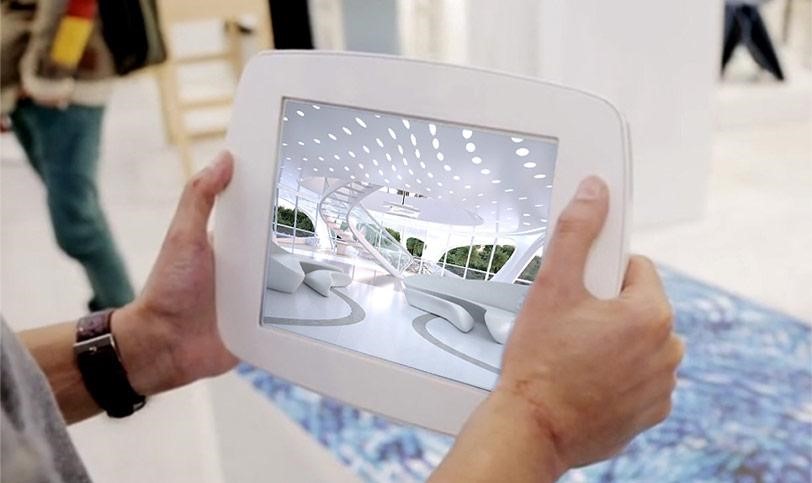

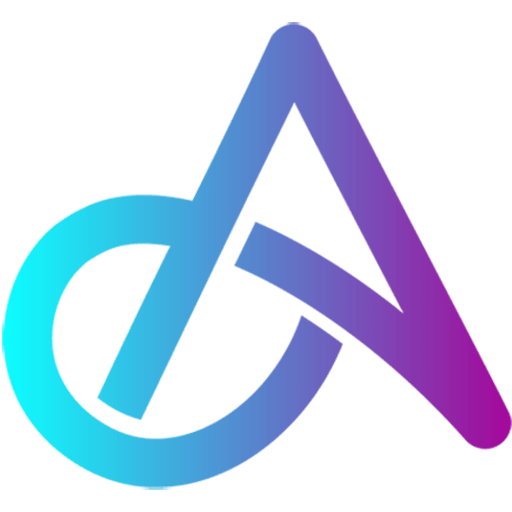
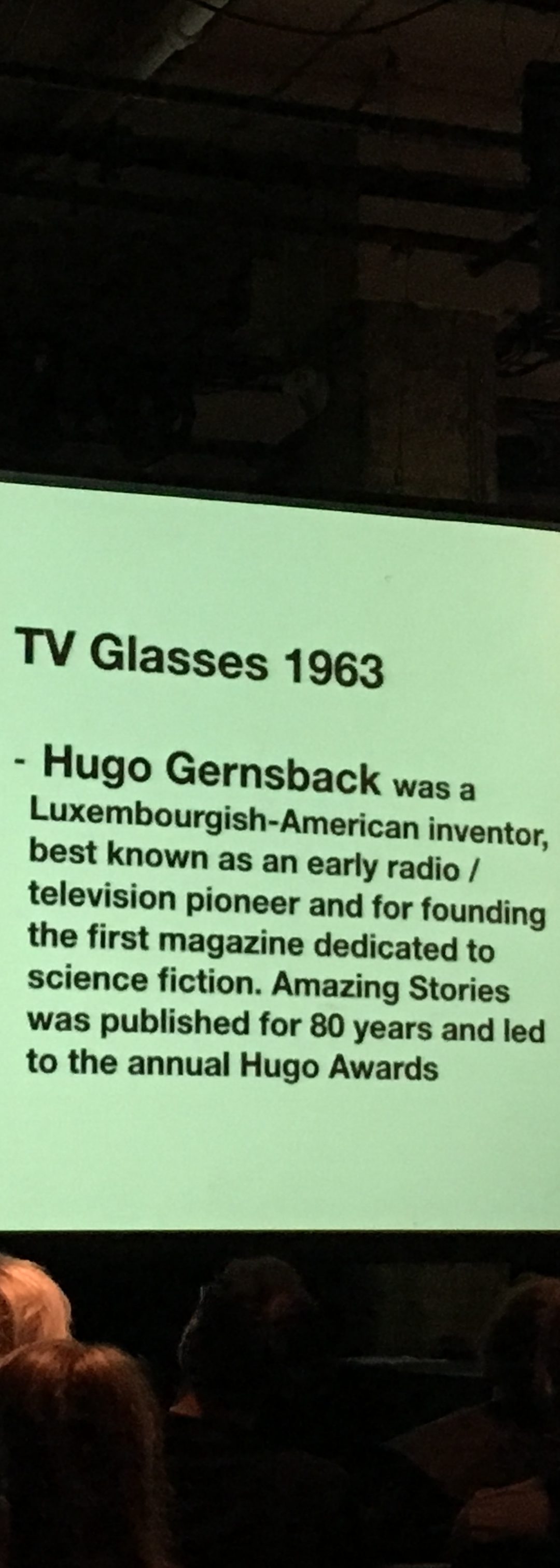

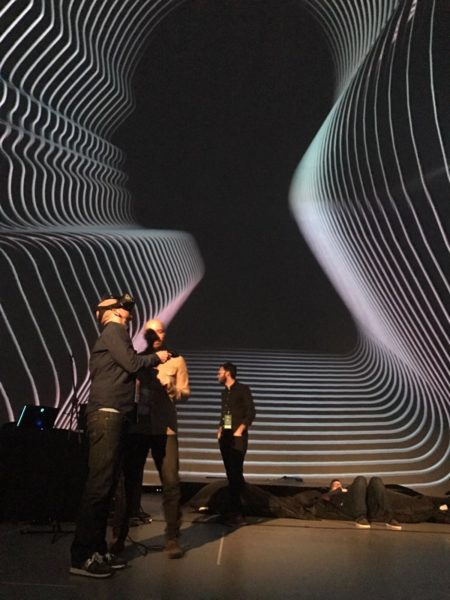




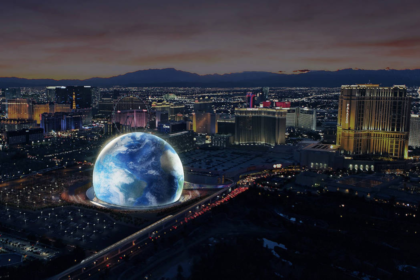


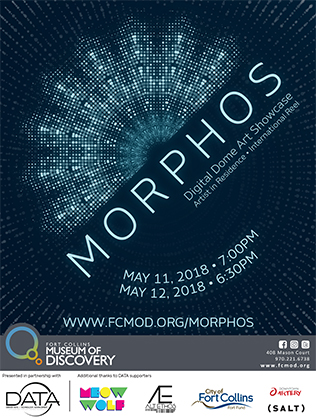 If you are an artist or fan in the Colorado Metro region, please join us at MORPHOS Digital Dome Programs including workshops, an artist in residency, and art show. For more information, please visit our sister nonprofit organization Denver Arts and Technology Advancement (
If you are an artist or fan in the Colorado Metro region, please join us at MORPHOS Digital Dome Programs including workshops, an artist in residency, and art show. For more information, please visit our sister nonprofit organization Denver Arts and Technology Advancement (